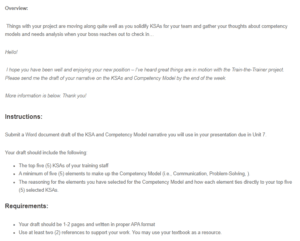KSAs and Competencies Draft
The Top Five (5) KSAs of My Training Staff
The success of the Train-the-Trainer project depends on the trainers’ ability to offer high-quality training that equips the trainees with the required skills and capabilities and creates a friendly environment for a better understanding of the concepts in the project. One of the KSAs that the training staff should have is planning and task coordination capabilities. The project entails a wide range of activities that need to be coordinated effectively to create a friendly learning environment and ensure that the trainees understand the content in their training program. Therefore, it is essential to properly coordinate those activities and plan to allocate the right amount of time for every activity.
The second KSA is conflict resolution. Conflicts are inevitable among trainees and between the trainees and the training staff, thus requiring conflict management skills to effectively find solutions and eliminate conflict. The third KSA is good communication skills. The training skills need to communicate the project’s goals effectively and clearly and give instructions to the trainees (Buckley & Caple, 2007). The fourth KSA is interpersonal skills. The training staff will interact with different kinds of people during the training program, thus the need for good interpersonal skills to avoid conflicts. The fifth KSA is adaptability. The training environment is susceptible to changes that could occur due to changes in the trainees’ behavior and their ability to grasp and retain the content they are trained. Therefore, the training staff needs to be adaptable and adjust accordingly.
Elements to make up the Competency Model
The main elements of the Competency Model are communication, relationship building, delegation, problem-solving, and program knowledge. These elements play a vital role in dictating the relationship between the trainees and the trainers hence contributing to the success or failure of the training program. For instance, relationship building promotes collaboration between the trainer and trainee, delegation fosters trainee commitment, problem-solving helps effectively resolve issues for better cooperation between the trainer and trainees, and communication helps pass knowledge to trainees.
Reasoning
Communication lays the foundation for the training program because it determines whether the trainees grasp what they are taught. Trainees need to maintain constant communication with the trainers and review their feedback to determine whether they understand what they are being trained for (Middleton & Price, 2021). Subsequently, trainees also need to communicate on any strategies they think are effective in making it easier to understand what they are trained. Trainers and trainees need to develop a relationship that allows the latter to feel free to express their concerns throughout the training process (Buckley & Caple, 2007). For instance, a trainee may require extra training time to understand the content of their training program. Relationship building is also essential in creating effective groups that trainees can use to discuss what they are taught and increase the ability to retain the knowledge and skills they are equipped with during the training program.
In addition, trainees also require problem-solving skills to deal with issues that may arise among the trainees and between the trainers and trainees. Common problems may include poor delegation of tasks and setting unrealistic goals and expectations for the trainees (Ali, 2015). Further, delegation is required to ensure that the program is completed within the timeline provided by top management. Trainers have to ensure that they delegate tasks based on the trainee’s skills and capabilities. For instance, the trainer may delegate the role of leading the trainees to one of the trainees with leadership skills. Trainers also need to know the program’s content to transfer the knowledge to the trainees.
References
Ali, J. M. (2015). Discordance persists between trainers’ and trainees’ perceptions of workplace-based assessment. Academic Medicine, 90(7), 839. https://doi.org/10.1097/acm.0000000000000746
Buckley, R., & Caple, J. (2007). The theory & practice of training. Kogan Page Publishers.
Middleton, P., & Price, M. (2021). The ‘difficult’ trainee: How do trainers deal with challenging trainees? The GP Trainer’s Handbook, 157-162. https://doi.org/10.1201/9780429084157-11
ORDER A PLAGIARISM-FREE PAPER HERE
We’ll write everything from scratch
Question

KSAs and Competencies Draft
Overview:
Things with your project are moving along quite well as you solidify KSAs for your team and gather your thoughts about competency models and needs analysis when your boss reaches out to check in…
Hello!
I hope you have been well and enjoying your new position – I’ve heard great things are in motion with the Train-the-Trainer project. Please send me the draft of your narrative on the KSAs and Competency Model by the end of the week.
More information is below. Thank you!
Instructions:
Submit a Word document draft of the KSA and Competency Model narrative you will use in your presentation due in Unit 7.
Your draft should include the following:
- The top five (5) KSAs of your training staff
- A minimum of five (5) elements to make up the Competency Model (i.e., Communication, Problem-Solving, ).
- The reasoning for the elements you have selected for the Competency Model and how each element ties directly to your top five (5) selected KSAs.
Requirements:
- Your draft should be 1-2 pages and written in proper APA format
- Use at least two (2) references to support your work. You may use your textbook as a resource.

